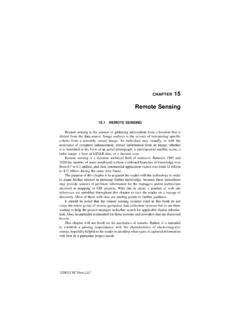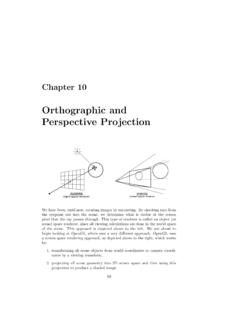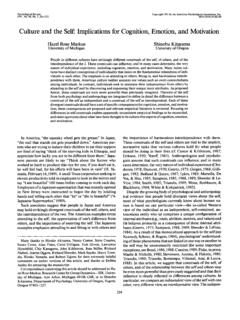Transcription of Geometry of Aerial Photographs* - GIS-Lab
1 2002 CRC Press LLC CHAPTER 6 Geometry of Aerial Photographs* SCALE EXPRESSIONS Map or photo scale can be stated in one of two expressions as applied to aerialmapping: representative fraction or engineers scale. Representative Fraction Representative fraction is expressed as a ratio in the form of 1:2400, where oneunit on the photo or map represents 2400 similar units on the ground. For example: 1 in. on the map/photo = 2400 in. on the ground1 ft on the map/photo = 2400 ft on the ground1 m on the map/photo = 2400 m on the ground Engineers Scale Engineers scale is expressed as a ratio in the form of 1 in. = 200 ft, where oneunit on the photo or map represents a number of different units on the ground. Scale Conversion Both of the examples of scale cited above mean the same thing. In order toconvert from a representative fraction of 1:2400, assume that both are in 2400 in.
2 Divided by 12 in. equals 200 ft, so the resultant engineers scale is1 in. = 200 ft. On the photo or map, 1 in. is equal to 200 ft on the , to convert from an engineers scale of 1 in. = 200 ft, multiply 200 ftby 12 in. This simple arithmetic exercise equates 1 in. on the map or photograph to2400 in. on the ground. The resultant representative fraction would be 1:2400. * The Geometry discussed in this chapter is reduced to several simple formulae that can be easily utilizedin planning Aerial photographic missions. 2002 CRC Press LLC Geometry OF PHOTO SCALE Figure identifies similar triangles A and B . Analogous parts of similar trian-gles are proportional. Therefore, n (negative width) is proportional to g (grounddistance covered by exposure) in the same magnitude as f (focal length) is to H (flight height above mean ground level).
3 Derivation of Photo Scale The derivation of photo scale (s p ) with Equation is a ratio which serves thepurpose of determining negat ive scale based on negative width related to grounddistance covered by the exposure frame.( )By factoring this ratio, the engineers scale is 1 in. = x ft. Figure Geometry of negative :1 ft 2002 CRC Press LLC Controlling Photo Scale Negative scale can be controlled by considering the specific mission character-istics. Negative scale is computed with the aid of Equation This defines therelationship between focal length and flight height above mean ground level.( )By factoring the ratio, the photo scale is 1 in. = x ft. Engineers Scale When using a 6-in. focal length camera flying at a height of 1200 ft above meanground elevation, the engineers scale of the photograph is:which translates to an engineers scale of 1 in.
4 = 200 ft. Representative Fraction This same situation can be utilized to calculate representative fraction, keepingin mind that a 6-in. focal length is equal to ft:which is analogous to a representative fraction of 1:2400. Scale Formula A simplified formula for determining photo scale, derived from the photo scaleratio, is presented in Equation ( )where:s p = photo scale denominator (feet)H = flight height above mean ground level (feet)f = focal length of camera (inches)sfHp=:1 ftsfHp==:612001 in. ft ftsfHp===0512001. ft ft ft2400 ftsHfp= 2002 CRC Press LLC Flight Height For photos exposed with most precision Aerial -mapping cameras, the calibratedfocal length is noted in the margin of the exposure. A derivation of Equation isEquation for calculating flight height once the photo scale is selected.( ) Relative Photo Scales There can be some confusion when thinking about relative photo scales.
5 Justremember, large scale means that image detail is relatively large, and small scalemeans that image detail is relatively small. The discernable village that is visible onthe photograph in Figure appears on a large-scale Aerial photo. Compare thiswith the photograph in Figure , which contains the same village in a small-scaleaerial photo. Figure Large-scale Aerial photograph. (Courtesy of Surdex Corporation, Chesterfield,MO.)Hs fp= 2002 CRC Press LLC PHOTO OVERLAP Aerial photo projects for all mapping and most image analyses require that aseries of exposures be made along each of the multiple flight lines. To guaranteestereoscopic coverage throughout the site, the photographs must overlap in twodirections: in the line of flight and between adjacent flights. Endlap Endlap, also known as forward overlap, is the common image area on consecutivephotographs along a flight strip.
6 This overlapping portion of two successive aerialphotos, which creates the three-dimensional effect necessary for mapping, is knownas a stereomodel or more commonly as a model. Figure shows the endlap areaon a single pair of consecutive photos in a flight all projects require more than a single pair of photographs. Usually,the aircraft follows a predetermined flight line as the camera exposes successiveoverlapping images. Figure Small-scale Aerial photograph. (Courtesy of Surdex Corporation, Chesterfield,MO.) 2002 CRC Press LLC Normally, endlap ranges between 55 and 65% of the length of a photo, with anominal average of 60% for most mapping projects. Endlap gain, the distancebetween the centers of consecutive photographs along a flight path, can be calculatedby using Equation ( )where:g end = distance between exposure stations (feet)s p = photo scale denominator (feet)o end = endlap (percent)w= width of exposure frame (inches)When employing a precision Aerial mapping camera with a 9 9 in.
7 Exposureformat and a normal endlap of 60%, the formula is simpler. In this situation, twoof the variables then become constants:w= 9 end = 60%Then, the expression w*[(100% o end )/100] becomes a constant equal to ,and Equation may be supplanted by Equation ( )When utilizing a camera other than a 9 9 in. format and/or an endlap other than60%, Equation must be employed. Figure Endlap on two consecutive photos in a flight ()[]100100qsendp= 36. 2002 CRC Press LLC Sidelap Sidelap, sometimes called side overlap, encompasses the overlapping areas ofphotographs between adjacent flight lines. It is designed so that there are no gapsin the three-dimensional cov erage of a multiline project. Figure shows the relativehead-on position of the aircraft in adjacent flight lines and the resultant area ofexposure , sidelap ranges between 20 and 40% of the width of a photo, with anominal average of 30%.
8 Figure portrays the sidelap pattern in a project requiringthree flight gain, the distance between the centers of adjacent flight lines, can becalculated by using Equation ( ) Figure Sidelap between two adjacent flight lines. Figure Sidelap on three adjacent flight ()[]100100 2002 CRC Press LLC where:g side = distance between flight line centers (feet)s p = photo scale denominator (feet)o side = sidelap (percent)w= width of exposure frame (inches)When employing a precision Aerial mapping camera with a 9 9 in. exposure formatand a normal sidelap of 30%, the formula is simpler. In this situation, two of thevariables then become constants:w= 9 side = 30%Then, the expression w*[(100% o side )/100] becomes a constant equal to , andEquation may be supplanted by Equation ( )When utilizing a camera other than a 9 9 in.
9 Format and/or a sidelap other than30%, Equation must be employed. STEREOMODEL From the foregoing discussion of overlap, it is evident that consecutive photosin a flight strip overlap. When focusing each eye on a particular image feature thatwas viewed by the camera from two different aspects, the mind of the observer isconvinced that it is seeing a lone object with three dimensions. Put simply, the three-dimensional effect is an optical illusion. This phenomenon of observing a featurefrom different positions is known as the parallax effect. Although used to describeother facets of photogrammetry, parallax is defined as a change in the position ofthe observer. This situation allows a viewer, when using appropriate stereoscopicinstruments, to observe a pair of two-dimensional photos and see a single three-dimensional envision a model as the neat area that a single stereopaircontributes to the total project.
10 This allows for the endlap and sidelap with surround-ing photos. A mapping model is shown as the crosshatched area in Figure is a tabulation relating photo scale to flight height using a camera witha 6-in. focal length. For a given photograph, several parameters can be found: Flight height (above mean ground level) Photo center interval Flight line spacing Acres per model (neat area)qssidep= 63. 2002 CRC Press LLC It must be realized that the scale of individual photographs in a project is not aconstant. Due to undulations in the aircraft flight and terrain relief, the distancebetween the camera and the ground differs from one exposure to another. Therefore,photo scale must be considered as an average scale for the total project. RELIEF DISPLACEMENT The surface of the earth is not smooth and flat. As a consequence, there is anatural phenomenon that disrupts true orthogonality of photo image features.






